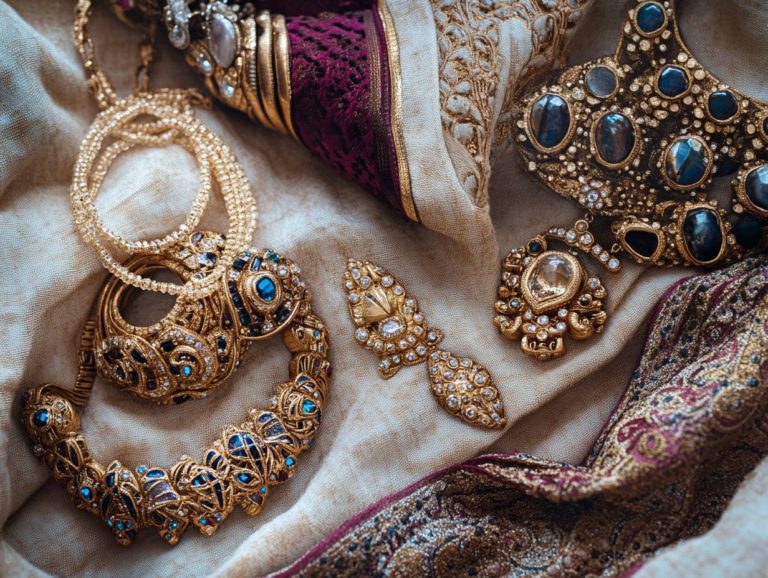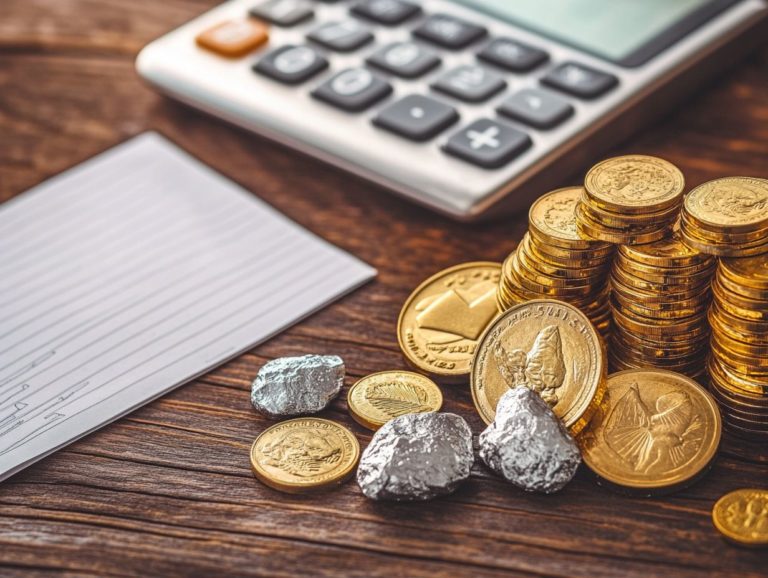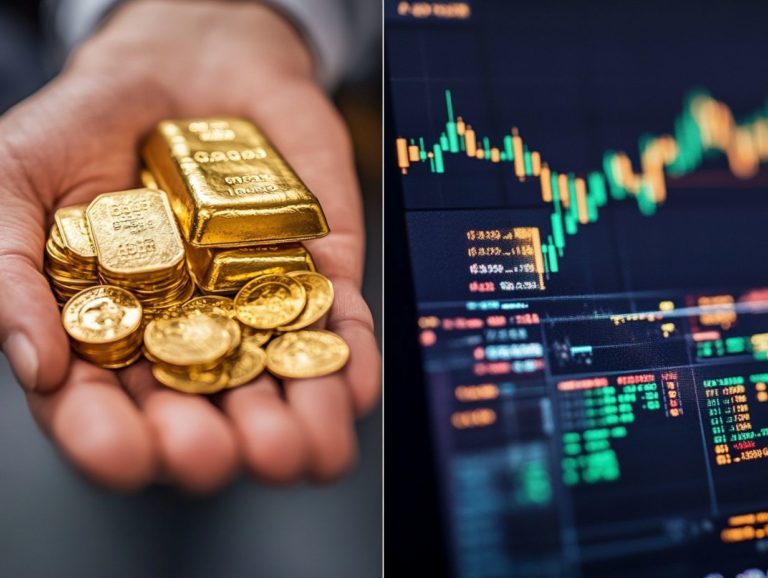Understanding Precious Metals: A Quick Overview
Precious metals have mesmerized humanity for centuries, valued for their exquisite beauty, intrinsic worth, and practical applications.
This article delves into the diverse types of precious metals, including gold, silver, and platinum, as well as their significant roles in both industrial and commercial realms.
It covers the benefits and risks tied to investing in these valuable resources, offers insights on how to identify and authenticate them, and shares best practices for their maintenance and storage.
Join us as we explore the exciting world of precious metals and their profound significance in commerce and investment.
Contents
Key Takeaways:
- Precious metals, such as gold, silver, and platinum, are rare and valuable elements used for a variety of purposes.
- From industrial and commercial applications to investment opportunities, understanding and utilizing precious metals offers many benefits.
- Knowing how to identify, authenticate, and properly store precious metals is crucial for maintaining their value over time.
What are Precious Metals?
Precious metals gold, silver, platinum, and palladium are very valuable due to their intrinsic qualities and rich historical significance. They serve as both tangible assets and effective hedges against inflation.
Their allure transcends various industries, establishing them as foundational elements of investment portfolios, particularly during times of economic uncertainty and geopolitical turmoil.
These metals boast unique physical properties, such as remarkable corrosion resistance and malleability, driving their extensive use in industrial applications, especially in electronics, jewelry, and automotive manufacturing.
Chemically, they exhibit low reactivity, ensuring their stability over time a characteristic that has captivated civilizations for centuries.
Historically, precious metals have not only functioned as currency but also as symbols of wealth, shaping trade and economies across diverse cultures. In today s economy, they remain essential, acting as valuable assets and crucial components in technologies like catalytic converters, which reduce harmful emissions in cars, and renewable energy systems.
This underscores their lasting relevance and adaptability in an ever-evolving landscape.
Types of Precious Metals
The realm of precious metals centers around four pivotal players: gold, silver, platinum, and palladium. Each of these metals boasts distinct characteristics and applications that drive market demand and shape sophisticated investment strategies.
Gold, Silver, Platinum, and More
Gold investment remains a compelling choice, especially if stability is what you seek. Meanwhile, silver showcases notable volatility in the market, while platinum and palladium present unique advantages, particularly in industrial applications like automotive catalysts and jewelry making.
This diverse array of precious metals caters to various investment strategies, with gold often seen as a safe haven during economic uncertainty. Discover why gold has a history of retaining value even in tough times!
On the flip side, silver might sway with price swings more often, but its applications in technology and renewable energy sectors enhance its allure. The rarity of platinum and the vital role of palladium in catalytic converters also highlight their significance in the automotive industry, offering even more diverse investment opportunities within the precious metals market.
Uses of Precious Metals
Precious metals hold immense value, serving a variety of purposes that range from industrial applications to the art of jewelry making and investment opportunities in futures.
Their multifaceted nature significantly shapes market demand across diverse sectors, making them a cornerstone of both commerce and culture.
Start your investment journey today and secure your future with precious metals!
Industrial and Commercial Applications
Industrial applications of precious metals play a crucial role in various sectors, particularly in automotive catalysts, photography, and electronics. Their unique properties significantly enhance the value of products and processes, directly influencing platinum prices and overall market dynamics.
In the automotive industry, for example, platinum and palladium are essential components of devices that reduce harmful vehicle emissions. They facilitate the conversion of harmful emissions into less toxic substances, improving vehicle efficiency and reducing environmental impact.
In the world of electronics, gold s exceptional conductivity enhances the performance and longevity of circuit boards and connectors, ensuring increased reliability for consumers.
Although the photography industry has become more niche, silver remains essential due to its unique light-sensitive properties, which are vital for producing high-quality images.
Each of these sectors not only demonstrates the multifunctional roles of precious metals but also underscores their profound impact on market fluctuations and prices, highlighting their significance in contemporary technology and commerce.
Investing in Precious Metals
Investing in precious metals like gold and silver offers you a valuable hedge against inflation and enhances diversification in your investment portfolio.
Commodity ETFs offer an easy way to invest in precious metals without the complexities of physical ownership.
Benefits and Risks
Investing in precious metals offers significant advantages, such as acting as a hedge against inflation and providing stability amid market fluctuations. However, as a prospective investor, you must also consider the inherent risks, including exposure to economic uncertainty and volatile mining stocks.
Now is the perfect time to explore how these metals can safeguard your investment! For many, the attraction of gold and silver lies in their historical resilience, often surpassing traditional investments during economic downturns. For example, during the 2008 financial crisis, gold surged by nearly 25%, demonstrating its protective qualities.
Incorporating precious metals into your investment portfolio can enhance diversification and potentially reduce overall risk. It’s essential to understand that prices can fluctuate dramatically due to geopolitical events or shifts in demand.
For instance, silver prices can swing significantly based on industrial demand, particularly from sectors like electronics. This dual-edged nature of precious metals requires you to approach investment strategies with careful consideration and a well-informed mindset.
How to Identify and Authenticate Precious Metals
Knowing how to identify and authenticate precious metals is crucial for smart buying! You need to grasp the various testing methods available and remain vigilant about potential red flags that could signal counterfeit products.
This diligence not only protects your investment but also ensures the integrity and intrinsic value of these valuable assets.
Testing Methods and Red Flags
Various testing methods, like acid tests and electronic testers, are essential for you if you’re looking to confirm the authenticity of precious metals. Staying vigilant for red flags such as unusual markings or suspiciously low prices will help ensure that the intrinsic value of your assets is preserved.
Among the most common techniques, the acid test involves applying a tiny drop of acid to the metal surface. The reaction will reveal the purity level, helping you determine its authenticity. Another reliable method is the electronic tester, which uses electrical conductivity and resistance to accurately gauge the metal’s quality.
As you utilize these technologies, be mindful of warning signs like mismatched hallmarks or vague seller histories; these could signal potential fraud. By understanding these testing methods and recognizing the red flags, you can navigate the market with a greater sense of confidence.
Maintaining and Storing Precious Metals
Maintaining and storing precious metals, such as physical gold and silver, demands strict adherence to best practices for preservation. By doing so, you ensure their long-term value and usability, particularly in areas like jewelry making and investment portfolios.
Best Practices for Preservation
To preserve your precious metals, take a thoughtful approach. Focus on safe storage, climate control, and regular inspections to protect your investments from environmental damage.
Start by securing your assets. Use a safe deposit box or a high-quality home safe to protect against theft.
Control humidity levels to prevent tarnishing and corrosion. Silica gel packs or a dehumidifier can help.
Regular maintenance is crucial. Clean your collection gently with the right materials to keep its beauty and integrity.
Consider getting insurance for your precious metals to gain peace of mind.
Integrate these practices to keep your collection safe and ready for long-term appreciation.
Frequently Asked Questions
What are precious metals?
Precious metals are rare metallic elements valued for their beauty and usefulness. They resist corrosion and conduct electricity well.
What are some examples of precious metals?
Common examples include gold, silver, platinum, and palladium. Less known options are rhodium, iridium, and ruthenium.
What makes precious metals valuable?
They are valuable because of their rarity, aesthetic appeal, and industrial uses. They also serve as a reliable store of value and a hedge against inflation.
How are precious metals mined and produced?
Precious metals are extracted from the Earth’s crust using various methods like surface mining, underground mining, and open-pit mining. They are then refined into forms like bars, coins, and jewelry.
What are the main uses of precious metals?
These metals are used in jewelry, electronics, dentistry, and medicine. They are also popular for investment and in producing currency and bullion coins.
How can I invest in precious metals?
You can invest by buying physical metals, investing in mining stocks, or purchasing precious metal exchange-traded funds (ETFs). Research the market before making investment decisions.





